AcpAS: An Advanced Circularly Polarized Antenna Structure for an Airborne Relay Communication System
Abstract
:1. Introduction
- This paper proposes a wide-beam dual-CP antenna that operates at the K- and Ka-bands, respectively, using a stepped septum polarizer to achieve dual-CP radiation at the K- and Ka-bands, and the beam width is broadened by loading a parabolic metal housing.
- This paper optimizes the septum polarizer for the antenna element and uses a side-fed coaxial-waveguide transition as the input structure of the septum polarizer, effectively reducing the impact of feeding structure errors on the performance of the septum polarizer.
- Extensive simulations and measurements were conducted on the two designed wide-beam dual-CP antennas, and the results show that the antennas have the characteristics of dual-CP, wide-beam coverage, and miniaturization.
2. Related Works
3. Design of AcpAS
3.1. Design of the Septum Polarizer
3.2. Optimization Design of the Coaxial to Waveguide Transition
3.3. Design of Antenna
4. Evaluation
4.1. Simulation on the Components of AcpAS
4.1.1. Simulation on the Septum Polarizer
4.1.2. Simulation on the Optimized Coaxial-to-Waveguide Transition
4.2. Test of the Antenna Structure
5. Conclusions
Author Contributions
Funding
Institutional Review Board Statement
Informed Consent Statement
Data Availability Statement
Conflicts of Interest
References
- Peng, W.; Li, M.; Li, Y.; Gao, W.; Jiang, T. Ultra-dense heterogeneous relay networks: A non-uniform traffic hotspot case. IEEE Netw. 2017, 31, 22–27. [Google Scholar] [CrossRef]
- Ran, Y. Considerations and suggestions on improvement of communication network disaster countermeasures after the Wenchuan Earthquake. IEEE Commun. Mag. 2011, 49, 44–47. [Google Scholar] [CrossRef]
- Seng, S.; Yang, G.; Li, X.; Ji, H.; Luo, C. Energy-efficient communications in unmanned aerial relaying systems. IEEE Trans. Netw. Sci. Eng. 2021, 8, 2780–2791. [Google Scholar] [CrossRef]
- Yin, S.; Zhao, Y.; Li, L.; Yu, F.R. UAV-assisted cooperative communications with time-sharing information and power transfer. IEEE Trans. Veh. Technol. 2020, 69, 1554–1567. [Google Scholar] [CrossRef]
- Li, B.; Fei, Z.; Zhang, Y. UAV communications for 5G and beyond: Recent advances and future trends. IEEE Internet Things J. 2019, 6, 2241–2263. [Google Scholar] [CrossRef]
- Zhang, S.; Liu, J. Analysis and optimization of multiple unmanned aerial vehicle-assisted communications in post-disaster areas. IEEE Trans. Veh. Technol. 2018, 67, 12049–12060. [Google Scholar] [CrossRef]
- Seng, S.; Luo, C.; Li, X.; Ji, H. Stable Communications in Green Unmanned Aerial Relaying Systems. IEEE Internet Things J. 2023, 10, 16675–16685. [Google Scholar] [CrossRef]
- Gómez, L.; Ibrahim, A.S. Design, Analysis and Simulation of Microstrip Antenna Arrays with Flexible Substrate in Different Frequency, for Use in UAV-Assisted Marine Communications. J. Mar. Sci. Eng. 2023, 11, 730. [Google Scholar] [CrossRef]
- Li, M.; Shang, Z.; Pu, L.; Tang, M.; Zhu, L. Low-Profile, Low Sidelobe Array Antenna with Ultrawide Beam Coverage for UAV Communication. Chin. J. Aeronaut. 2024; in press. [Google Scholar]
- He, C.; Xie, Z.; Bian, D.; Zhong, X. Study of interference localization using single satellite based on signal strength distribution in multi-beam antenna for satellite communications system. Int. J. Distrib. Sens. Netw. 2018, 14, 61–71. [Google Scholar] [CrossRef]
- Li, H.; Huang, Y.; Chu, J.; Liu, X.; Wu, C.; Li, D. Research on Inter-satellite and Satellite-Ground Communication Based on Multi-beam-Phased-Array Antenna. Commun. Signal Process. Syst. 2019, 515, 134–141. [Google Scholar]
- Lee, H.; Kim, Y.; Lee, H.L. Reconfigurable Antenna for UAV-Assisted Wide Coverage Air-to-Ground Communications. IEEE Access 2022, 10, 1. [Google Scholar] [CrossRef]
- Adomnite, C.; Lesanu, C.; Done, A.; Yu, A.; Dimian, M.; Lavric, A. The Design and Implementation of a Phased Antenna Array System for LEO Satellite Communications. Sensors 2024, 24, 1915. [Google Scholar] [CrossRef] [PubMed]
- Nikulin, A.V.; Kosmynin, A.N.; Burtsev, V.D.; Prokhorov, S.Y.; Vosheva, T.S.; Filonov, D.S. Towards phased array antenna operating in Ku-band for satellite communications. Photonics Nanostructures Fundam. Appl. 2024, 58, 101216. [Google Scholar] [CrossRef]
- Yang, Y.H.; Sun, B.H.; Guo, J.L. A Low-Cost, Single-Layer, Dual Circularly Polarized Antenna for Millimeter-Wave Applications. IEEE Antennas Wirel. Propag. Lett. 2019, 18, 651–655. [Google Scholar] [CrossRef]
- Chakrabarti, S. Composite feed dual circularly polarized microstrip antenna with improved characteristics. Microw. Opt. Technol. Lett. 2016, 58, 283–289. [Google Scholar] [CrossRef]
- Zhu, W.; Xiao, S.; Yuan, R.; Tang, M. Broadband and dual circularly polarized patch antenna with H-shaped aperture. In Proceedings of the 2014 International Symposium on Antennas and Propagation Conference Proceedings, Kaohsiung, Taiwan, 2–5 December 2014; pp. 549–550. [Google Scholar]
- Ibrahim, K.M.; Hassan, W.M.; Abdallah, E.A.; Attiya, A.M. Wideband sequential feeding network for Ku-band dual circularly polarized 4 × 4 antenna array. Int. J. RF Microw. Comput.-Aided Eng. 2020, 30, 1–12. [Google Scholar] [CrossRef]
- Gao, K.; Ding, X.X.; Gu, L.; Zhao, Y.W.; Nie, Z.P. A broadband dual circularly polarized shared-aperture antenna array using characteristic mode analysis for 5G applications. Int. J. RF Microw. Comput.-Aided Eng. 2021, 31, 1–10. [Google Scholar] [CrossRef]
- Chen, Q.; Zhang, H.; Yang, L.C.; Li, H.P.; Zhong, T.; Min, X.L.; Tan, S.L. Novel dual-band asymmetric U-shaped slot antenna for dual-circular polarization. Int. J. RF Microw. Comput.-Aided Eng. 2017, 27, e21047. [Google Scholar] [CrossRef]
- Xu, L.; Lu, W.L.; Yuan, C.Y.; Zhu, L. Dual circularly polarized loop antenna using a pair of resonant even-modes. Int. J. RF Microw. Comput.-Aided Eng. 2019, 29, e21703. [Google Scholar] [CrossRef]
- Wei, C.; Zhou, M.; Ding, K.; Yu, F.X.; Mo, J.J.; Zhao, X.L. Compact wideband dual circularly polarized L-shaped slot antenna. Microw Opt. Technol. Lett. 2018, 60, 1685–1691. [Google Scholar] [CrossRef]
- Xu, R.; Li, J.Y.; Liu, J.; Zhou, S.G.; Wei, K.; Xing, Z.J. A simple design of compact dual-wideband square slot antenna with dual-sense circularly polarized radiation for WLAN/Wi-fi communications. IEEE Transac. Antennas Propag. 2018, 66, 4884–4889. [Google Scholar] [CrossRef]
- Saini, R.K.; Dwari, S. A broadband dual circularly polarized square slot antenna. IEEE Transac. Antennas Propag. 2016, 64, 290–294. [Google Scholar] [CrossRef]
- Qi, J.; Han, C.; Lin, S.; Qiu, J. Dual circularly polarized broadband CPW-fed square slot antenna with two L-shape strips. In Proceedings of the 2014 IEEE Antennas and Propagation Society International Symposium (APSURSI), Memphis, TN, USA, 6–12 July 2014; pp. 1722–1723. [Google Scholar]
- Saini, R.K.; Dwari, S.; Mandal, M.K. CPW-fed dual-band dual-sense circularly polarized monopole antenna. IEEE Antennas Wirel Propag. Lett. 2017, 16, 2497–2500. [Google Scholar] [CrossRef]
- Chandu, D.S.; Karthikeyan, S.S. A novel broadband dual circularly polarized microstrip-fed monopole antenna. IEEE Transac. Antennas Propag. 2017, 65, 1410–1415. [Google Scholar]
- Liu, Y.; Cheng, Y.J.; Zhao, M.-H.; Fan, Y. Dual-band shared-aperture high-efficiency reflectarray antenna based on structure-reuse technique. IEEE Antennas Wirel. Propag. Lett. 2021, 20, 366–370. [Google Scholar] [CrossRef]
- Tong, X.; Jiang, Z.H.; Li, Y.; Wu, F.; Sauleau, R.; Hong, W. Dual-wideband dual-circularly-polarized shared-aperture reflectarrays with a single functional substrate for K-/Ka-band applications. IEEE Trans. Antennas Propag. 2022, 70, 5404–5417. [Google Scholar] [CrossRef]
- Abdollahvand, M.; Forooraghi, K.; Encinar, J.A.; Atlasbaf, Z.; Martinez-de-Rioja, E. A 20/30 GHz reflectarray backed by FSS for shared aperture Ku/Ka-band satellite communication antennas. IEEE Antennas Wirel. Propag. Lett. 2020, 19, 566–570. [Google Scholar] [CrossRef]
- Deng, R.; Xu, S.; Yang, F.; Li, M. An FSS-backed Ku/Ka quad-band reflectarray antenna for satellite communications. IEEE Trans. Antennas Propag. 2018, 66, 4353–4358. [Google Scholar] [CrossRef]
- Cai, Y.M.; Li, K.; Li, W.; Gao, S.; Yin, Y.; Zhao, L.; Hu, W. Dual-band circularly polarized transmitarray with single linearly polarized feed. IEEE Trans. Antennas Propag. 2020, 68, 5015–5020. [Google Scholar] [CrossRef]
- Mei, P.; Zhang, S.; Pedersen, G.F. A dual-polarized and high-gain X-/Ka-band shared-aperture antenna with high aperture reuse efficiency. IEEE Trans. Antennas Propag. 2021, 69, 1334–1344. [Google Scholar] [CrossRef]
- Zhu, J.; Yang, Y.; Hou, Z.; Liao, S.; Xue, Q. Dual-band aperture-shared high gain antenna for millimeter-wave multi-beam and sub-6 GHz communication applications. IEEE Trans. Antennas Propag. 2022, 70, 4848–4853. [Google Scholar] [CrossRef]
- Guo, Z.J.; Hao, Z.C.; Yin, H.Y.; Sun, D.M.; Luo, G.Q. Planar-shared-aperture array antenna with a high isolation for millimeter-wave low Earth orbit satellite communication system. IEEE Trans. Antennas Propag. 2021, 69, 7582–7592. [Google Scholar] [CrossRef]
- Zhang, J.D.; Wu, W.; Fang, D.G. Dual-band and dual-circularly-polarized shared-aperture array antennas with single-layer substrate. IEEE Trans. Antennas Propag. 2016, 64, 109–116. [Google Scholar] [CrossRef]
- Bruns, C.; Leuchtmann, P.; Vahldieck, R. Analysis and simulation of a 1–18 GHz broadband double-ridged horn antenna. IEEE Trans. Electromagn. Compat. 2003, 45, 55–60. [Google Scholar]
- Tan, C.Y.; Selvan, K.T. Simulation study of a 4–28 GHz double ridged conical horn antenna. In Proceedings of the 2008 IEEE International RF and Microwave Conference, Kuala Lumpur, Malaysia, 2–4 December 2008; pp. 298–301. [Google Scholar]
- Mallahzadeh, A.R.; Imani, A. Double ridged antenna for wideband application. Prog. Electromagn. Res. 2009, 91, 273–285. [Google Scholar] [CrossRef]
- Jazani, G.; Pirhadi, A. Design of dual-polarised (RHCP/LHCP) quad-ridged horn antenna with wideband septum polariser waveguide feed. IET Microwaves Antennas Propag. 2018, 12, 1541–1545. [Google Scholar] [CrossRef]
- Han, K.K.; Wei, G.; Lei, S.Y.; Qiu, C.L.; Qiu, T.C. A design of broadband dual circularly polarized antenna. Int. J. RF Microw. Comput.-Aided Eng. 2021, 31, 1–8. [Google Scholar] [CrossRef]
- Bornemann, J.; Labay, V.A. Ridge waveguide polarizer with finite and stepped-thickness septum. IEEE Trans. Microw. Theory Tech. 1995, 43, 1782–1787. [Google Scholar] [CrossRef]
- Ege, T.; McAndrew, P. Analysis of Stepped Septum Polarizers. Electron. Lett. 1985, 21, 1166–1168. [Google Scholar] [CrossRef]
- Levy, R.; Hendrick, L.W. Analysis and synthesis of in-line coaxial-to-waveguide adapters. In Proceedings of the 2002 IEEE MTT-S International Microwave Symposium Digest, Seattle, WA, USA, 2–7 June 2002. [Google Scholar]
- Durga, M.; Tomar, S.; Singh, S.; Suthar, L. Millimeter wave in-line coaxial-to-rectangular waveguide transition. In Proceedings of the 2011 IEEE Applied Electromagnetics Conference (AEMC), Kolkata, India, 18–22 December 2011; pp. 1–3. [Google Scholar]
- Pozar, D.M. Microwave Engineering; Wiley: Hoboken, NJ, USA, 2008. [Google Scholar]
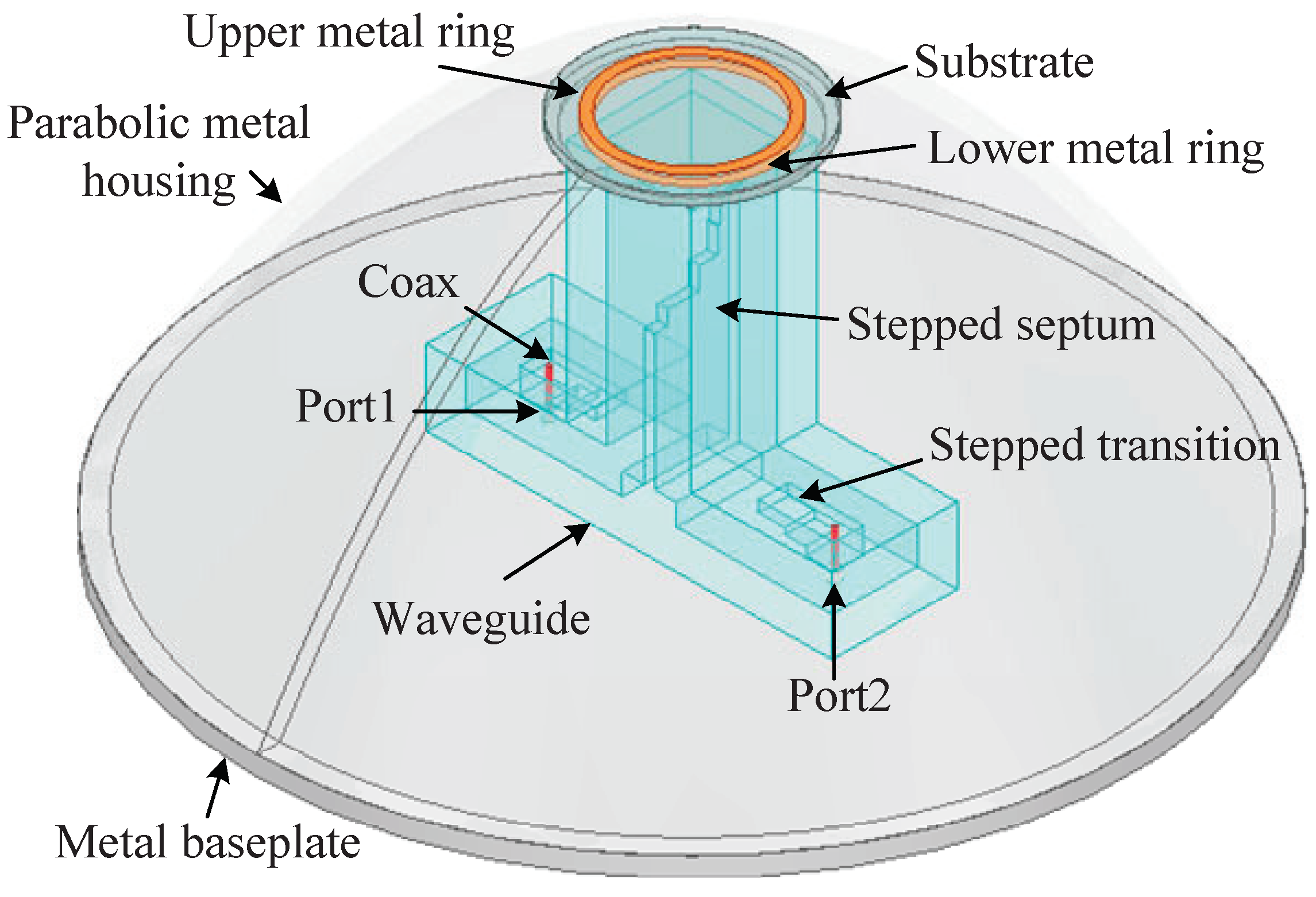

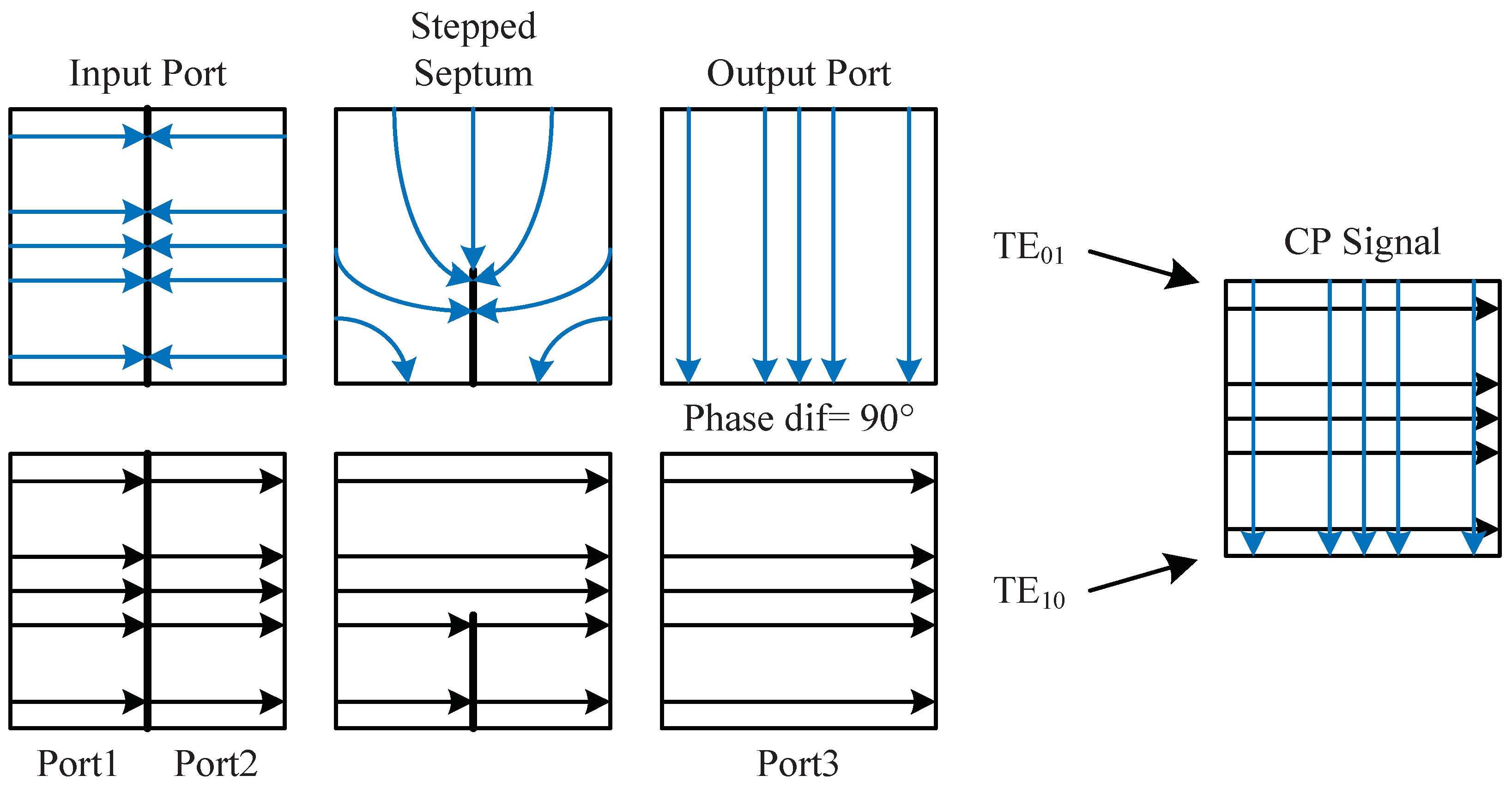

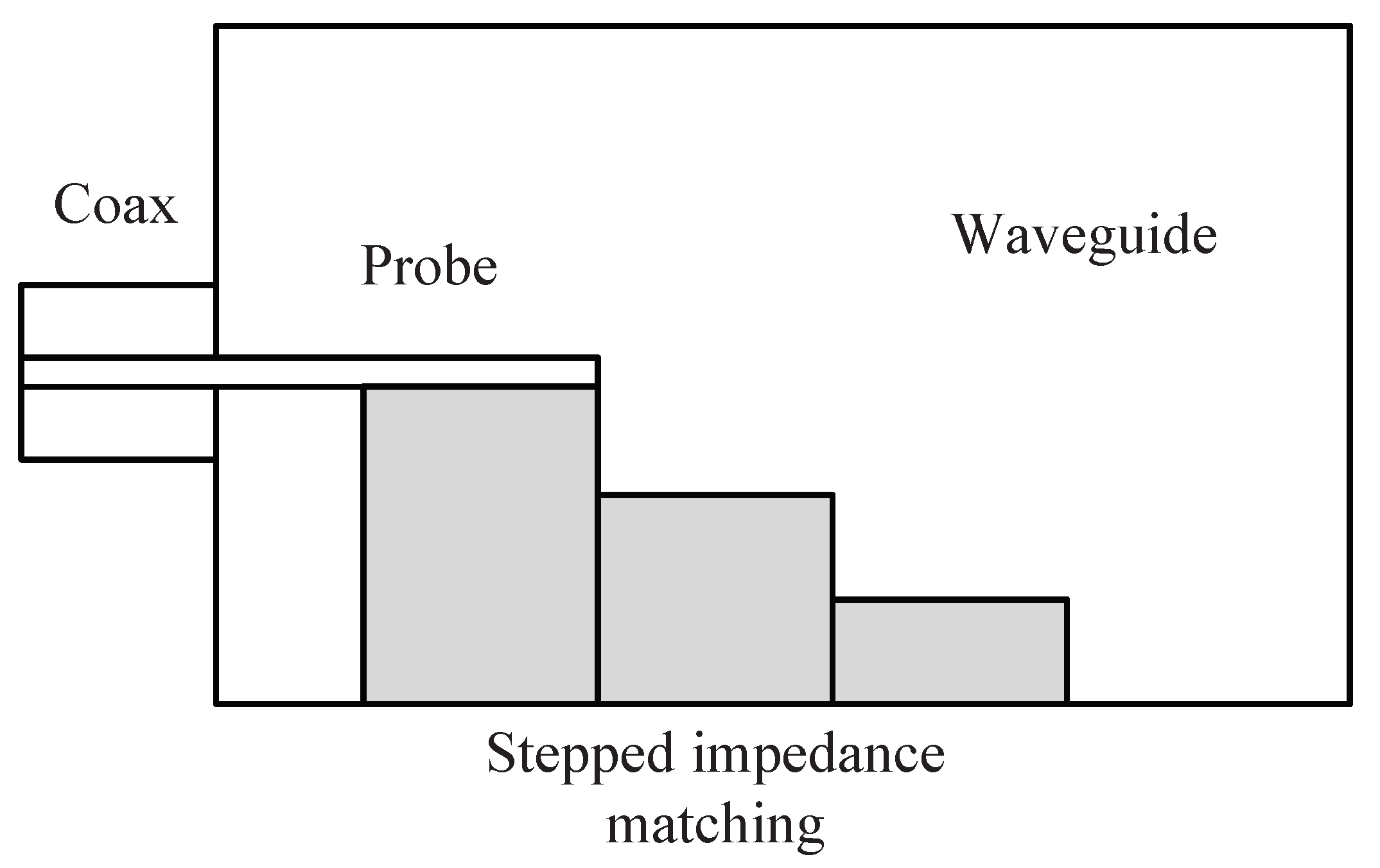
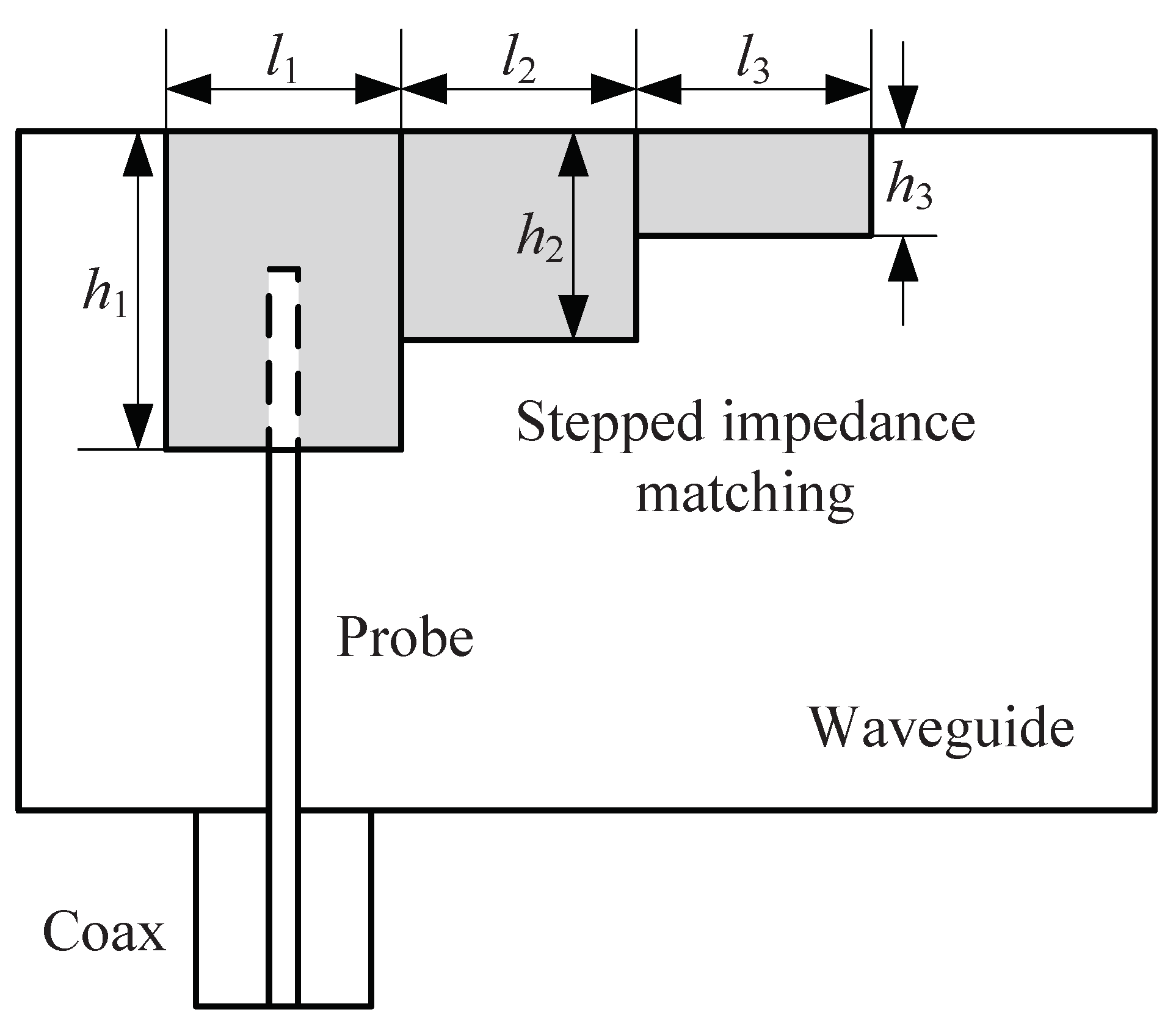
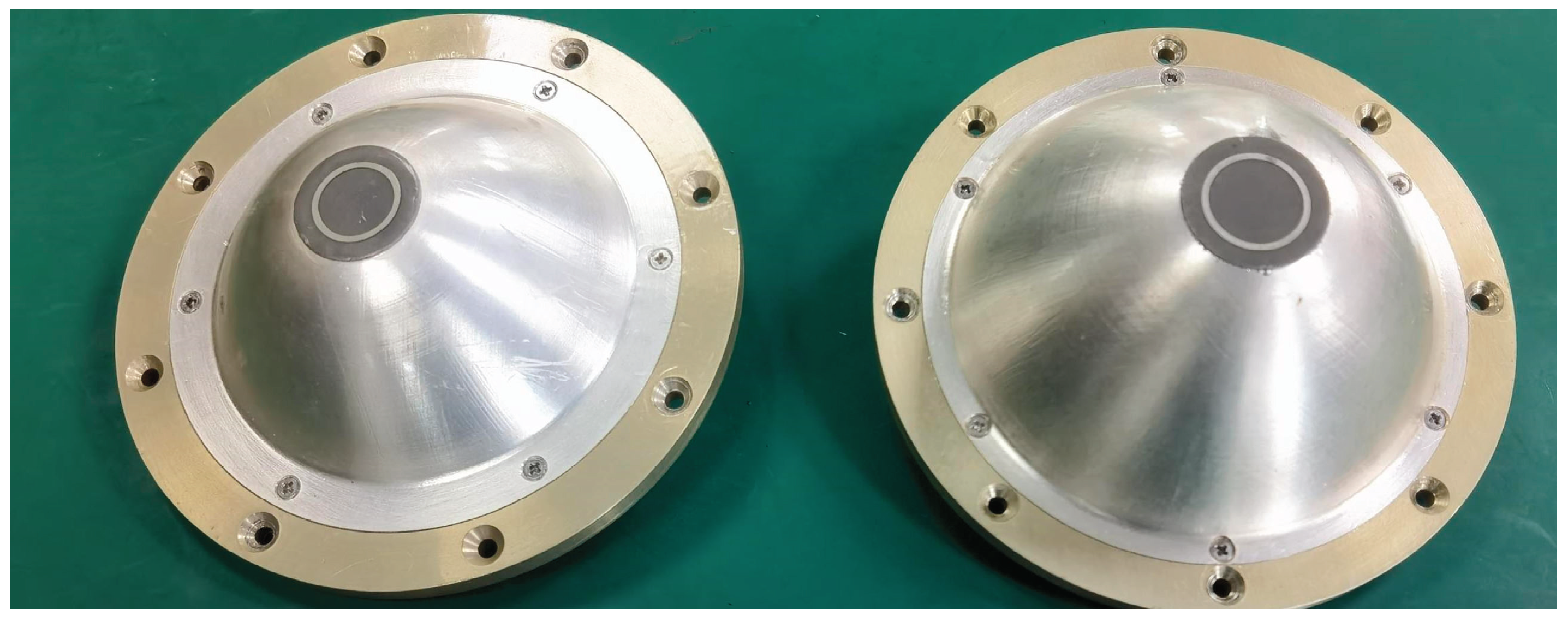
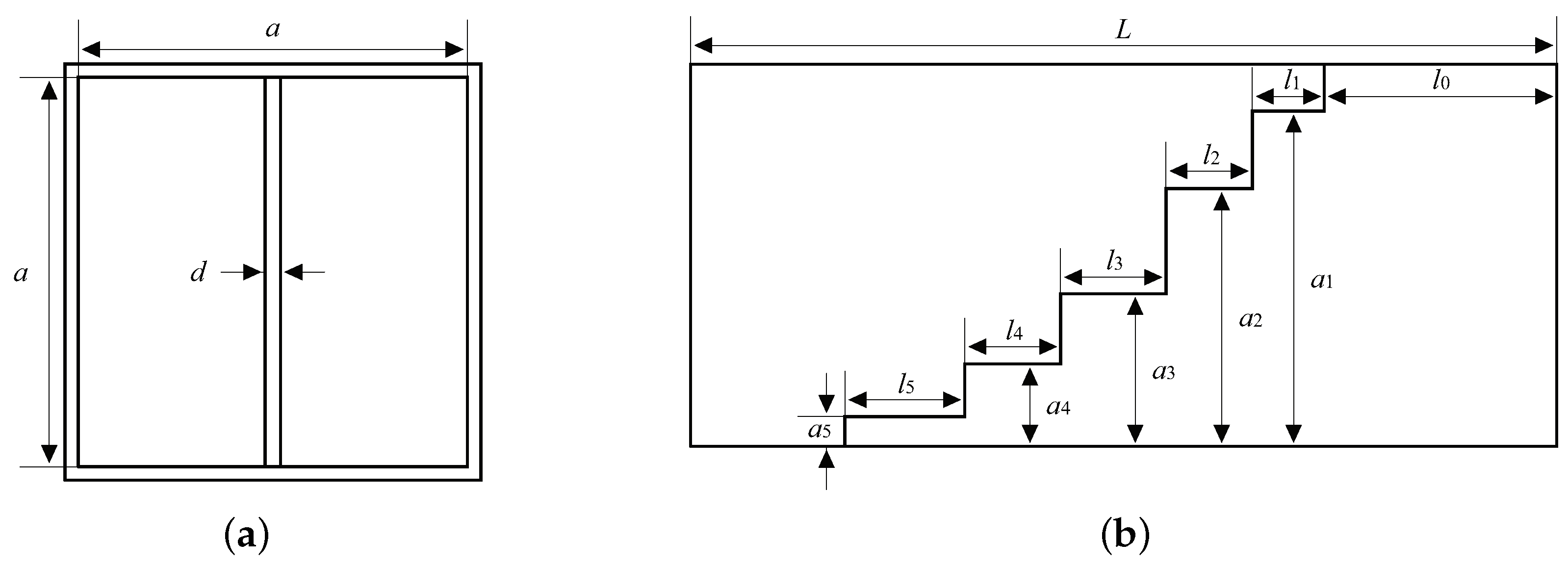



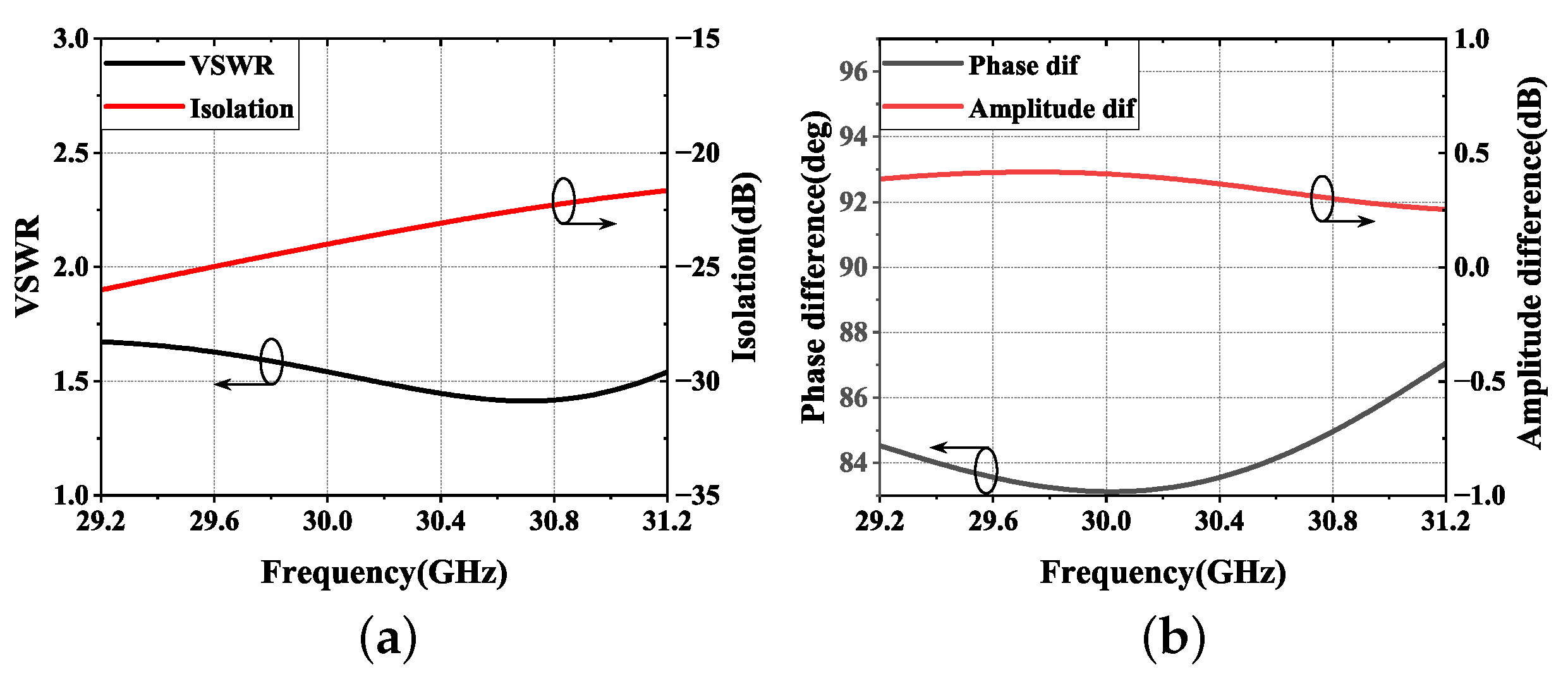
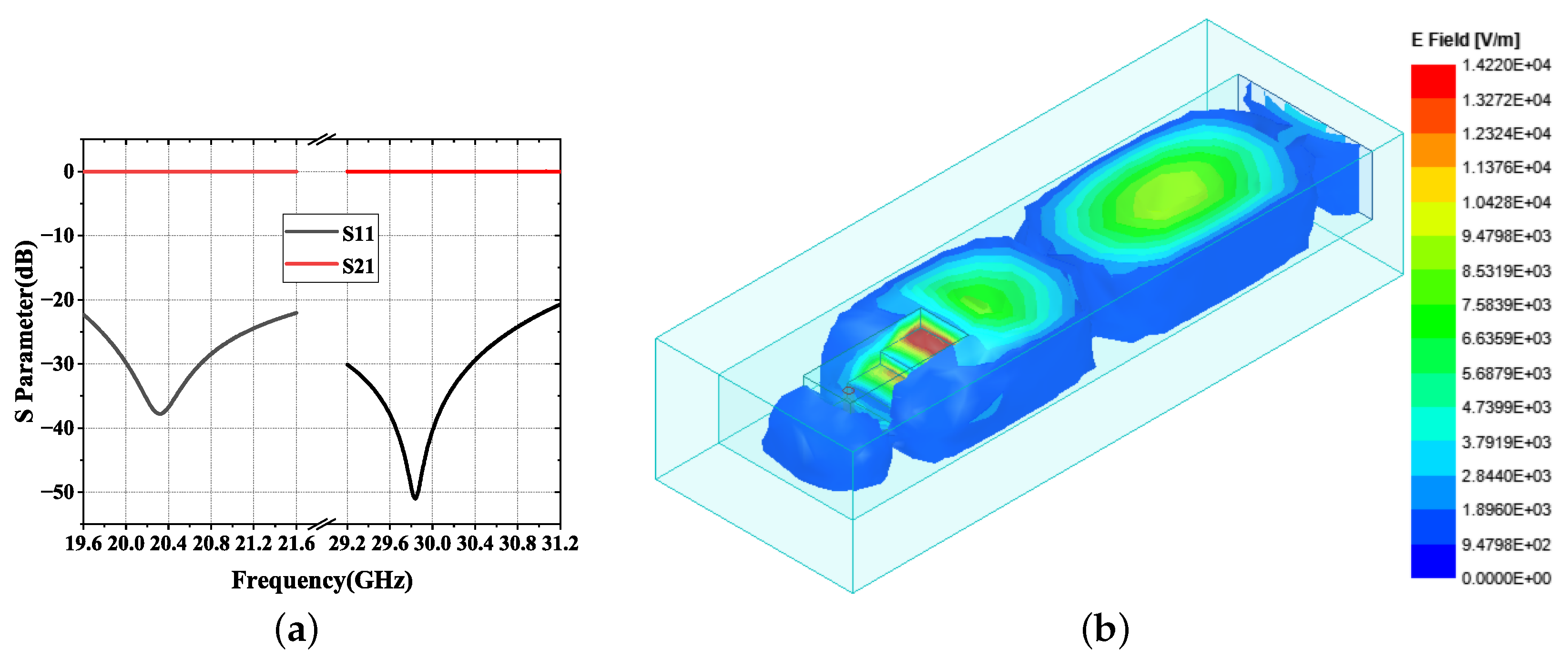


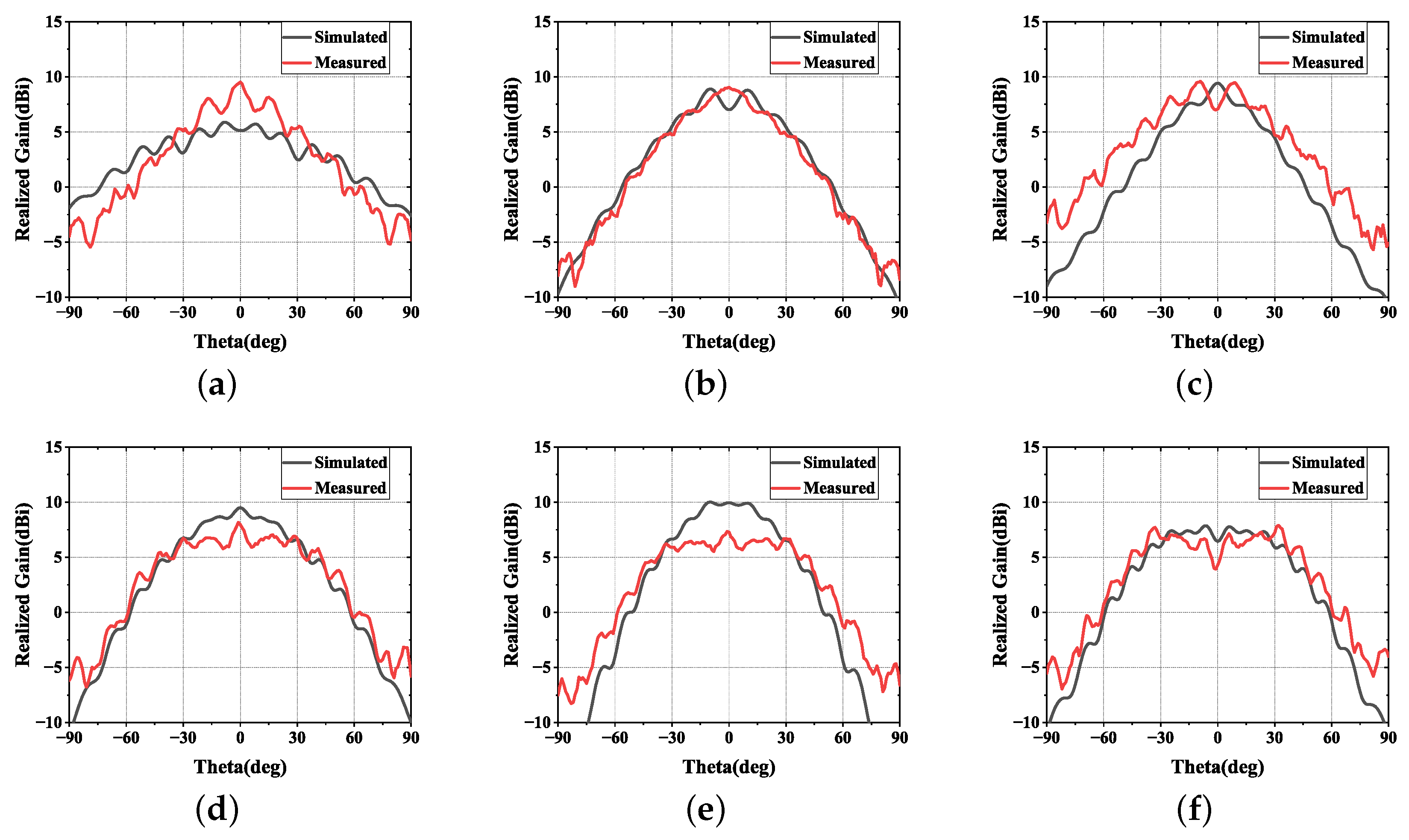
| K-band | 2.6 | 1.8 | 1.1 | 2.8 | 2.1 | 2.6 |
| Ka-band | 2 | 1.3 | 0.56 | 2.6 | 1.9 | 2.2 |
| Length Para. | a | d | L | |||||||||||
|---|---|---|---|---|---|---|---|---|---|---|---|---|---|---|
| K-band | 8.5 | 1 | 34.82 | 16.02 | 1.51 | 2.29 | 2.65 | 2.38 | 1.05 | 7.14 | 4 | 2.22 | 2.01 | 0.24 |
| Ka-band | 6.3576 | 0.5 | 22.8 | 7.86 | 1.19 | 2.06 | 2.58 | 2.25 | 1.86 | 5.06 | 2.99 | 2.23 | 1.12 | 0.62 |
Disclaimer/Publisher’s Note: The statements, opinions and data contained in all publications are solely those of the individual author(s) and contributor(s) and not of MDPI and/or the editor(s). MDPI and/or the editor(s) disclaim responsibility for any injury to people or property resulting from any ideas, methods, instructions or products referred to in the content. |
© 2024 by the authors. Licensee MDPI, Basel, Switzerland. This article is an open access article distributed under the terms and conditions of the Creative Commons Attribution (CC BY) license (https://creativecommons.org/licenses/by/4.0/).
Share and Cite
Ma, X.; Huang, S.; Ye, G.; Guan, T.; Fan, Q. AcpAS: An Advanced Circularly Polarized Antenna Structure for an Airborne Relay Communication System. Appl. Sci. 2024, 14, 9041. https://doi.org/10.3390/app14199041
Ma X, Huang S, Ye G, Guan T, Fan Q. AcpAS: An Advanced Circularly Polarized Antenna Structure for an Airborne Relay Communication System. Applied Sciences. 2024; 14(19):9041. https://doi.org/10.3390/app14199041
Chicago/Turabian StyleMa, Xin, Shan Huang, Ganhua Ye, Tao Guan, and Qiang Fan. 2024. "AcpAS: An Advanced Circularly Polarized Antenna Structure for an Airborne Relay Communication System" Applied Sciences 14, no. 19: 9041. https://doi.org/10.3390/app14199041




